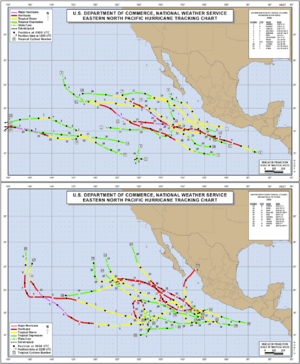1985 Pacific hurricane season facts for kids
 |
|
| Season summary map | |
| First storm formed | June 5, 1985 |
|---|---|
| Last storm dissipated | November 21, 1985 |
| Strongest storm | Rick – 145 mph (230 km/h) (1-minute sustained) |
| Total depressions | 28 |
| Total storms | 24 |
| Hurricanes | 13 |
| Major hurricanes (Cat. 3+) | 8 |
| Total fatalities | Unknown |
| Total damage | Unknown |
| Pacific hurricane seasons 1983, 1984, 1985, 1986, 1987 |
|
The 1985 Pacific hurricane season was a time when many strong storms formed in the Pacific Ocean. It officially began on May 15, 1985, for the eastern Pacific and June 1, 1985, for the central Pacific. The season ended on November 30, 1985. These dates are when most tropical storms and hurricanes usually happen in this part of the world.
In 1985, this season was one of the busiest ever for the eastern North Pacific. A total of 25 tropical cyclones formed. Out of these, 22 became tropical storms, 12 grew into hurricanes, and 8 became "major hurricanes." Major hurricanes are very strong storms, reaching Category 3 or higher on the Saffir-Simpson Scale.
Even though there were many storms, only a few caused problems. Hurricane Waldo was the only storm to hit land, causing damage in Mexico. Hurricane Pauline caused big waves in Hawaii, which washed some things onto roads.
Contents
Notable Storms of 1985
Hurricane Pauline
Hurricane Pauline caused large waves along the Big Island of Hawaii. These waves washed debris onto the roads. Luckily, no damage was reported. The storm was strong enough to make people worried. A hurricane watch was put in place. This means that winds of 74 miles per hour or more might happen within 36 hours. However, the hurricane changed direction and moved away from the islands.
Hurricane Rick
Rick was the strongest storm of the 1985 season. At that time, it had the second strongest winds ever recorded for a tropical cyclone in the Central Pacific Ocean. This powerful storm might have also caused a sailing boat to go missing.
Hurricane Terry
Terry was a very powerful major hurricane. It formed around September 15. Four days later, on September 19, it became a major hurricane. However, it stayed far out at sea and did not affect any land. Terry eventually weakened and disappeared by September 24. This happened because the conditions in the ocean were no longer good for it to stay strong.
Hurricane Waldo
Tropical Depression Twenty Three-E started from a weather disturbance on October 7. It grew very quickly because it was over warm ocean waters (about 86 degrees Fahrenheit). It became a tropical storm on the same day it formed. Waldo moved towards the coast of Mexico.
Just after it reached its strongest point as a Category 2 hurricane, Waldo hit land. It made landfall southwest of Culiacán, Mexico. Once it moved over land, Waldo quickly lost its strength and disappeared. There was a lot of damage reported in Mexico, but thankfully, no one died. This was the only storm of the season to hit land.
Hurricane Xina
Xina was the twenty-second storm of the season, which was a record at the time. It formed on October 25. It became Tropical Storm Xina early on October 27. Xina then started to move in a large, oval loop. It reached its strongest point as a minimal major hurricane on October 29.
As Xina finished its loop, it moved away from an area that was helping it stay strong. The storm then started to fall apart. Cooler ocean waters also made the cyclone weaken. Xina finally disappeared on November 5. This storm stayed out at sea, so it did not cause any injuries or damage.
1985 Storm Names
The names listed below were used for the storms that formed in the eastern Pacific in 1985. None of these names were taken out of use, so they were used again in the 1991 season. The name "Dolores" was spelled wrong as "Delores" in 1991. This list is mostly the same as the one used in the 1979 season, but with some new names added.
The names Kevin, Linda, Marty, Nora, Olaf, Pauline, Rick, Sandra, Terry, Vivian, Waldo, and Xina were used for the first time in 1985. Names that were not used are shown in gray.
|
|
|
|
One name from the Central Pacific list was used: Nele. This was the first time this name was used. Another storm, Typhoon Skip, formed in the central Pacific. However, it did not get a name until it moved into the western Pacific. So, only Nele was used from the central Pacific list.
Later in the 1980s, the names that were added this year became a regular part of the Eastern Pacific naming lists. Other names were also added for years ending in an even number.
Related pages
Images for kids


